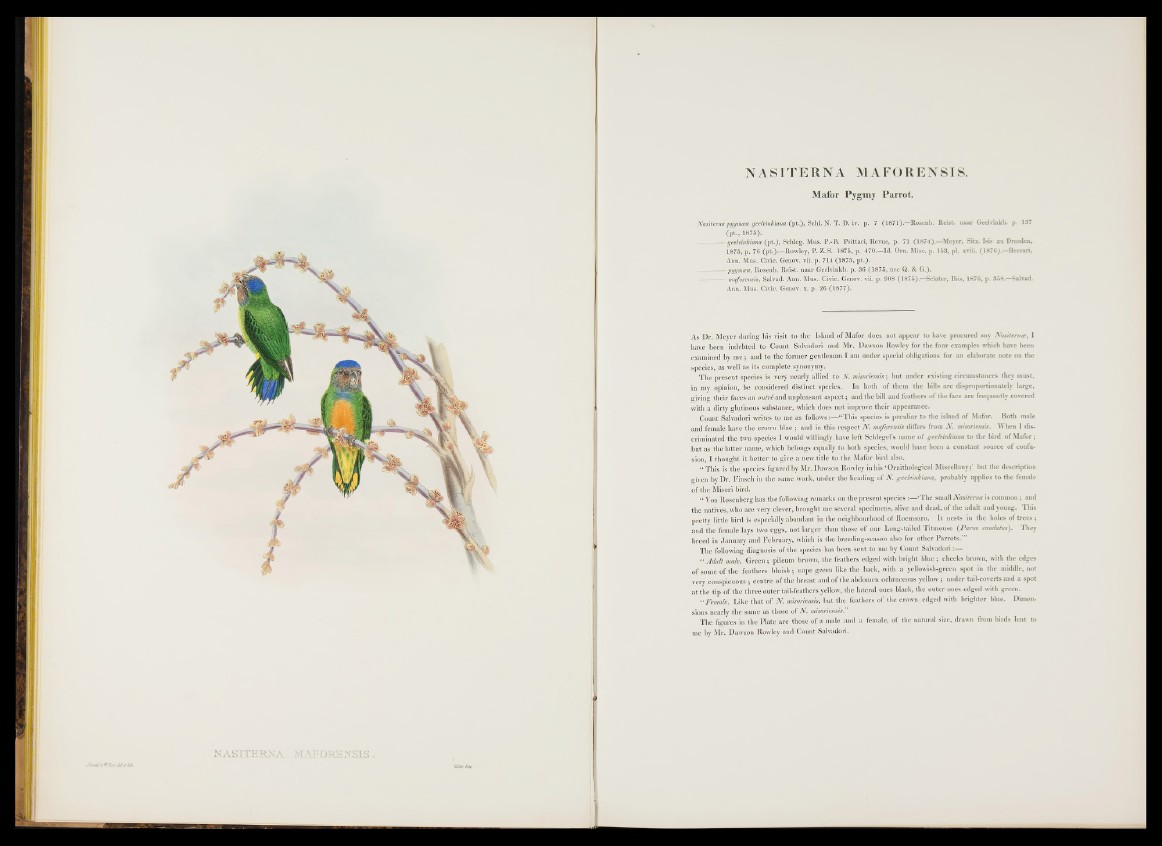
Mafor Pyg*my Parrot.
Nasiterna pygmcea geelvinkiana (pt.), Schl. N. T. D. iv. p. 7 (1871).—Rosenb. Reist, naar Geelvinkb. p. 137
(p t., 1875).
— geelvinkiana (p t.), Sehleg. Mus. P.-B. Psittaci, Revue, p. 71 (1874).—Meyer, Sitz. Isis zu Dresden,
1875, p. 76 (pt.).—Rowley, P. Z. 'S'! 1875, p. 470.—Id. Orn. Mise. p. 153, pl. xviii. (1876).—Beccari,
Ann. Mus. Civic. Genov, vii. p. 714 (1875, pt.).
-------------pygmcea, Rosenb. Reist, naar Geelvinkb. p. 36 (1875, nec Q. & G.).
— maforensis, Salvad. Ann. Mus. Civic. Genov, vii. p. 908 (1875).—Sclater, Ibis, 1876, p. 358.—Salvad.
Ann. Mus. Civic. Genov, x. p. 26 (1877).
As D r. Meyer during his visit to the Island o f Mafor does not appear to have procured any Nasiternce, I
have been indebted to Count Salvadori and Mr. Dawson Rowley for the four examples which have been
examined by m e ; and to the former gentleman I am under special obligations for an elaborate note on the
species, as well as its complete synonymy.
T h e present species is very nearly allied to N. misoriensis; but under existing circumstances they must,
in my opinion, be considered distinct species. In both of them the bills are disproportionately large,
giving their faces an outre and unpleasant a sp ec t; and the bill and feathers o f the face are frequently covered
with a dirty glutinous substance, which does not improve their appearance.
Count Salvadori writes to me as follows :■— “ This species is peculiar to the island o f Mafor. Both male
and female have the crown blue ; and in this respect N . maforensis differs from N . misoriensis. When I discriminated
the two species I would willingly have left Schlegel’s name o f geelvinkiana to the bird o f Mafor;
but as the latter name, which belongs equally to both species, would have been a constant source o f confusion,
I thought it better to give a new title to the Mafor bird also.
“ T his is the species figured by M r. Dawson Rowley in his ‘Ornithological Miscellany;’ but the description
given by D r. Finsch in the same work, under the heading o f N . geelvinkiana, probably applies to the female
of the Misori bird.
“ Von Rosenberg has the following remarks on the present species :— ‘T he small Nasiterna is common ; and
the natives, who are very clever, brought me several specimens, alive and dead, o f the adult and youug. This
pretty little bird is especially abundant in the neighbourhood of Roemsaro. I t nests in the holes o f trees ;
and the female lays two eggs, not larger than those o f our Long-tailed Titmouse (Parus caudatus). They
breed in Jan u ary and February, which is the breeding-season also for other Parrots.’”
T h e following diagnosis o f the species has been sent to me by Count Salvadori:—
“ A du lt male. Green ; pileum brown, the feathers edged with bright blue ; cheeks brown, with the edges
o f some of the feathers b lu ish ; nape green like the back, with a yellowish-green spot in the middle, not
very conspicuous ; centre of the breast and o f the abdomen ochraceous yellow ; under tail-coverts and a spot
a t the tip o f the three o u ter tail-feathers yellow, the lateral ones black, the outer ones edged with greeu.
“ Female. Like th at o f N . misoriensis, but the feathers o f the crown edged with brighter blue. Dimensions
nearly the same as those o f N . misoriensis.
T h e figures in the Plate a re those o f a male and a female, o f the natural size, drawn from birds lent to
me by Mr. Dawson Rowley and Count Salvadori.